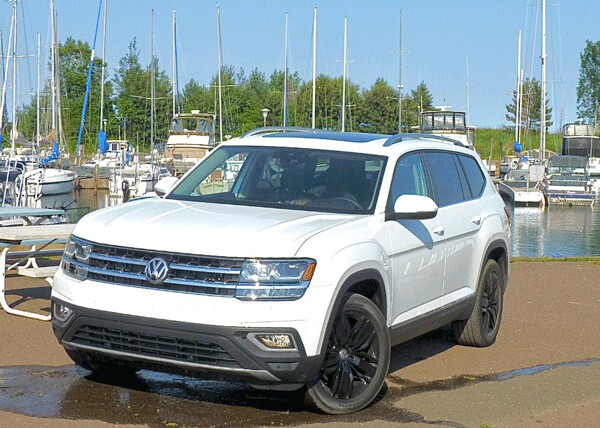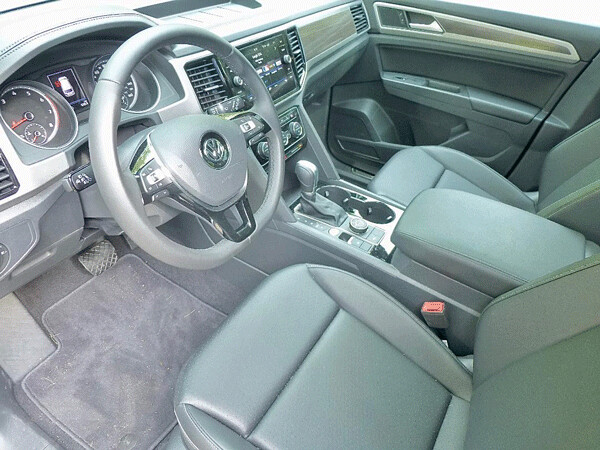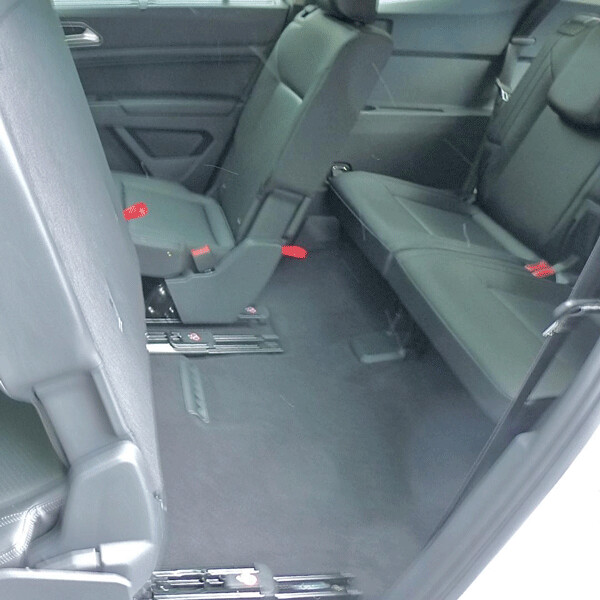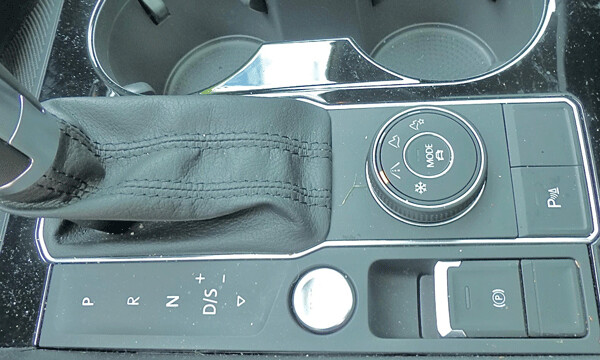News & Articles
Browse all content by date.


Where will it all end, this apparent runaway escalation in number and size of Sport-Utility Vehicles? For Volkswagen, we figure the end is here, in the form of the large, and extremely spacious Atlas. Our test drive timing made the Atlas the perfect vehicle to help us find the perfect piece of blueberry pie.
The Atlas is the largest vehicle Volkswagen has ever built, and it is a new dimension from a company that has made its impact by building compact, fuel-efficient and fun cars, such as the Beetle, Golf, former Rabbit, Jetta, and on up to the larger Passat and longer Sportwagon.
We loaded up a new Atlas with four adults, my camera bag, spare hiking shoes, a windbreaker/rain jacket each, just in case, and a cooler full of sparkling Perrier and iced tea, and we headed off with a half-dozen CDs in the console on a quest to find blueberry pie. We had to make our second trip in a couple weeks to Ely, Minnesota, way up in the North Woods adjacent to the Boundary Waters Canoe Area Wilderness, but then what other city within a day-trip’s drive has a Blueberry Festival?
There’s something about Minnesota blueberries in the middle of summer. They thrive where some other areas have a tough time growing them effectively. Up North, you find two varieties of blueberries — the large, marble sized prizes raised carefully by nurturing gardeners, and the little tiny blueberries growing wild in the woods. There is no question the tiny ones have unexcelled intensity in their flavor, but you have to spend a lot of time down low to the ground to find the beds where they flourish.
In any case, the various places that make and sell fresh blueberry pies could charge anything they wanted for a slice of those delicacies. And we wanted to go right up to the large weekend festival that fills Ely’s city park with displays off all sorts of handiwork. When we first walked in to the crowded square block site, we spotted the facility that sold various light foods and also proclaimed boldly: “Blueberry Pie.”
But we’d driven for most of two hours and we were patient. It was a hot day, but we could wander around the many displays and hold off on satisfying our quest until later. We did hit the kettle-corn stand for a large sack of their specialty, and when we heard some fine harmony from a nearby stage, we wandered over and were thoroughly entertained by Pat Surface with the Boundary Water Boys, performing a series of folk-country classics.




On the way up, we appreciated the way the Atlas handled the many twisting curves and hills through the towering pine trees and between the lakes and rivers. It is one of the most fun highways in the country, driven moderately, of course. The Atlas comes in base form with VW’s long-proven 2.0-liter, 4-cylinder turbo, but ours had the optional 3.6-liter V6 with 276 horsepower and 266 foot-pounds of torque, with plenty of punch to handle those curves.
The loaded SEL model listed at $42,940, and it was a large cave that had room for everything we needed, and we were glad that we had a large enough SUV to handle our stuff in spacious comfort. We never needed to fold the third row seat up into position, although it would have been easy. The second row not only tilts forward, it automatically slides 7.7 inches forward to allow easy access to the third row, when needed. If you’re in the second row, you’ll appreciate the 14-degree reclining action.
VW tried its hand at a compact SUV years ago with the Tiguan and the Touareg, a pair of larger, stronger utility vehicles that I’m sure the company figured would satisfy anyone wanting a bigger, stronger vehicle.
But in our now-global autoworld, look around. Used to be that the General Motors Suburban and smaller sibling Tahoe, and its GMC brethren called the Yukon, plus Ford’s response with the Expedition. Dodge countered but within reason with the Durango, but the secret got out to some top European competitors, such as Mercedes Benz, which has always had utility vehicles even if they weren’t common in the U.S. Of course, Land Rover has also been building Range Rovers and other strong, sturdy utilities.
In Japan, Toyota came out swinging with the highly competent and trouble-free Land Cruiser, and added to the arsenal with the enormous Sequoia, and provided accompanying giant SUVs for Lexus, such as the LX. Nissan kept up, and set sail with its Armada class, while giving its upscale Infiniti line a QX80.
All of the above varieties were speeding down the superhighway to oblivion when gas prices rose to threaten the financial security of entire nations. But just before they could all go the way of the dinosaur, gas prices came down, oil production went up, and entire societies that had made logical decisions to seek more fuel-efficient vehicles, even if it meant downsizing their super-sized SUVs, changed direction almost immediately.
As a credit to the human spirit, our industry had built more fuel-efficient vehicles that got better gas mileage, so they were able to go back to oversized vehicles with overpowered engines and get passable fuel mileage. But that doesn’t alter my basic philosophy — buy the smallest SUV that’s big enough, and the most economical engine that has enough punch, then you’ll appreciate it even more when you get decent mileage.
Of course, what Volkswagen noticed all this time was that the companies with oversized vehicles were making their biggest profits from their large SUVs. The best VW customers, who might have kept their Golfs and Jettas and added a Passat or Tiguan, started to veer away to buy a huge Suburban or Expedition or Mercedes or Toyota, lining the bank accounts of those companies while VW was going along with much more restrained profits from their small cars.
I’ll never forget a Porsche executive I interviewed, during the introduction of the Porsche Cayenne SUV. “Why,” I asked him, “would the creater of the world’s best sports cars want to make an SUV?”
The fellow smiled ever so slightly and said: “So that we can afford to keep making the world’s best sports cars.”
Simple as that. Sure enough, they sold enough Cayennes to finance the next generation of 911s and Boxsters.
It’s the same with Volkswagen. The company may not have any societal interest in joining the larger-SUV trend, but it is a way to keep the loyal VW buyers loyal. If you admire the strong feel, the solid security and the durability of a Golf or Jetta, then you understand how you might find a VW SUV a strong temptation.
The Tiguan met some of that concept, and the Touareg more, and the newest Tiguan has grown by almost a foot and added a third-row seat.
But for 2018, Volkswagen also introduced the Atlas. It looked huge at introduction, and it is huge, by VW standards. With 4Motion, VW’s own all-wheel-drive system, and direct injection sending fuel into the staggered-cylinder narrow-angle V6, all controlled by an 8-speed automatic, the Atlas did its job without complaint. We got 22-23 miles per gallon on the highway.
As we were about to leave the Blueberry Festival, we stopped for a bottle of root beer for $2.25, made by the company that took over the legendary woodland treats once made by “the Root Beer Lady” of Ely. We were happy to learn they had, without fanfare, gone away from the high-fructose corn syrup they had been using and went to sugar. Then it was time to head for the same exit we came in, for our long-awaited piece of blueberry pie. The sign said: “Sold out.”
You can’t be sold out of blueberry pie in midafternoon of a Sunday at Blueberry Festival, can you? Apparently you can.
We hit the road and headed south on Hwy. 1, bypassing our usual turn-off toward Two Harbors and continuing all the way down to Hwy. 61. The plan was a good one. We would get to the Rustic Inn, our favorite restaurant in the state, for some sort of feast, and we knew Beth Sullivan would have an array of over a dozen pies, including her legendary blueberry.
We got there, and while Joan got the best barbecued ribs we’ve tasted, I got the special, grilled Alaskan salmon. And for dessert, we put in our order before we ate — we need two pieces of blueberry pie. “Sorry,” said the new waiter we had, “we’re sold out of blueberry pie.”
Afterward, back in the Atlas, we cruised down Hwy. 61 marvelling at the view of the full moon about to rise over the Wisconsin horizon, and we listened to the satellite radio broadcast of the Twins game at Boston — from those historic days when the infield included Brian Dozier at second base and Eduardo Escobar at third. At the time, we didn’t know how special that would be.
| Tweet |


